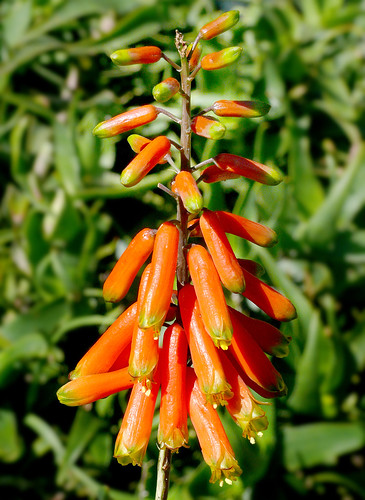Questions on Flower Life Cycle Help Please?
How are flowers a benefit to a plant?
What is the function of the flower petals?
What is produced in the anthers? _____By what process?_______
What is produced in the pistil (carpal)? _______ By what process? _______
How are fruits a benefit to a plant?
What makes up a fruit?
The top of the pistil, the stigma, is often sticky. What is the benefit in that?
Contrast the location of seeds in angiosperms and gymnosperms?
inflorescence best answer:
Answer by Saraha
1. The aesthetic guarantee of a continued place within nature and the attraction of pollinators are two explanations as to how flowers benefit their plant.
2. The basic function of the petal is to attract insects and mamals to the flower for pollination; to a certain degree they also off a small amount of protection to the reproductive structures.
The petals are also called the inflorescence of the the flower.
In Dicotyledonous flowers the petals are protected when young by the calyx.
In Dicotyledonous plants the flowers either have petals in multiples of 4 or 5 (eg. 4, 8, 12 or 5, 10, 15 etc.).
In Monocotyledonous plants the flower have petals in multiples of 3 (eg. 3, 6, 9 etc.).
Some petals are brightly coloured and are pleasant for humans to look at.
Flowers that sometimes appear drab to humans are patterned in ways that are visible to animals and insects, but not us - they may contain pigments and patterns that are only visible in utraviolet light (which some insects can see).
Petals have no function in photosynthesis.
3. The anther is the part of the flower that holds the pollen. This and the filament both make up the stamen. Anther generally has four pollen sacs in a dithecous anther and in a monothecous anther like that of hibiscus there are 2 pollen sacs and each pollen sacs hold a microsporangium which produces pollen grains that how anther plays a main role in the development of pollen grains.
4. Part of the pistil holds the ovule(s) and is located above or below or at the point of connection with the base of the petals and sepals. The pistil may be made up of one carpel or of several fused carpels, and therefore the ovary can contain part of one carpel or parts of several fused carpels.
5. It is benefited because fruits are the means by which flowering plants disseminate seeds. Evolution has led plants to adopt certain basic mechanisms, seemingly without close regard to the tissues involved. No one terminology really fits the enormous variety that is found among plant fruits. Botanical terminology for fruits is inexact and will remain so.
6. It is made when a flower is pollinated, the fruit starts to form around it and may perform several purposes ), protecting it from harm, helping it to travel by air or water, drawing a herbivore which may carry the seed elsewhere after it has eaten the fruit.
7. It is sticky to best catch the pollen grains.
8. You can get the last answer at http://www.seedbiology.de/evolution.asp
angiosperms is another word for flowering plants and they are divided into to cactegories
gynaecium is another word for carpel...the carpel is the female part of the flower, it is made up of the stigma, style, ovary and ovule....HOPE I HELPED :D
inflorescence
Aloe ciliaris var. ciliaris #2

Best viewed @ large size
Asphodelaceae - South Africa
Climbing Aloe
Shown: Detail of inflorescence
"Aloe, also written Aloë, is a genus containing about four hundred species of flowering succulent plants. The most common and well known of these is Aloe vera, or "true aloe".
"The genus is native to Africa, and is common in South Africa's Cape Province, the mountains of tropical Africa, and neighbouring areas such as Madagascar, the Arabian peninsula, and the islands off Africa.
"The APG II system (2003) placed the genus in the family Asphodelaceae. In the past it has also been assigned to families Aloaceae and Liliaceae or lilly family. Members of the closely allied genera Gasteria, Haworthia and Kniphofia, which have a similar mode of growth, are also popularly known as aloes. Note that the plant sometimes called American aloe (Agave americana) belongs to Agavaceae, a different family.
"Most Aloe species have a rosette of large, thick, fleshy leaves. The leaves are often lance-shaped with a sharp apex and a spiny margin. Aloe flowers are tubular, frequently yellow, pink or red and are borne on densely clustered, simple or branched leafless stems.
"Many species of Aloe appear to be stemless, with the rosette growing directly at ground level; other varieties may have a branched or unbranched stem from which the fleshy leaves spring. They vary in colour from grey to bright-green and are sometimes striped or mottled. Some Aloes native to South Africa are arborescent." (Wikipedia)
Detailed description of Aloe ciliaris var. ciliaris:
www.plantzafrica.com/plantab/aloecilcil.htm
Additional views:
farm4.static.flickr.com/3538/3359033666_05b8b9c596_b.jpg
farm3.static.flickr.com/2569/4223889401_72b063c837_b.jpg
Photographed in San Francisco Botanical Garden - San Francisco, California
Orignal From: Questions on Flower Life Cycle Help Please? and Aloe ciliaris var. ciliaris #2
No comments:
Post a Comment